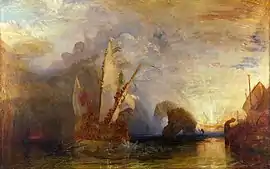Ulysses Deriding Polyphemus
Ulysses Deriding Polyphemus is an 1829 oil painting by Joseph Mallord William Turner. It depicts a scene from Homer's Odyssey, showing Odysseus (Ulysses) standing on his ship deriding Polyphemus, one of the cyclopes he encounters and has recently blinded, who is disguised behind one of the mountains on the left side.[1] Additional details include the Trojan Horse, a scene from Virgil's Aeneid, on one of the flags and the horses of Apollo rising above the horizon.[2] This painting is thought to be quickly done as a replacement for previous paintings submitted to the Academy that had been delayed.[1] The painting was exhibited at the Royal Academy of Arts in 1829.[3] Acquired by the National Gallery in 1856, the painting is on display in room 34.[4]
| Ulysses Deriding Polyphemus | |
|---|---|
 | |
| Artist | J. M. W. Turner |
| Year | 1829 |
| Medium | Oil on canvas |
| Dimensions | 132.7 cm × 203 cm (52.2 in × 80 in) |
| Location | National Gallery, London |
See also
References
- Warrell, Ian. J.M.W. Turner. London: Tate Publishing. p. 162.
- "London National Gallery Next 20 15 JMW Turner – Ulysses deriding Polyphemus". National Gallery. Retrieved 30 July 2014.
- "Ulysses deriding Polyphemus – Homer's Odyssey". The National Gallery. Retrieved 30 July 2014.
- "Key Facts". National Gallery. Retrieved 30 July 2014.